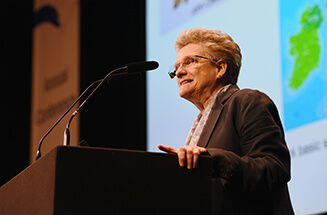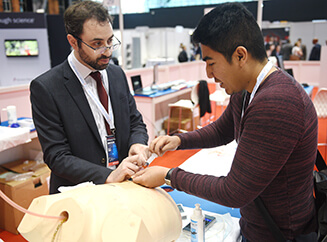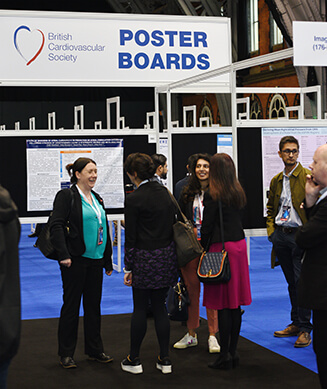The British Cardiovascular Society (BCS) annual conference returned to the Manchester Central Convention Complex on the 3–5 June 2024. This year’s focus was our most important stakeholder, the patient – highlighting how research, pharmaceutical and technological advancements are improving patient outcomes, and the importance of value-based care.

Heart failure – best of times
The conference was opened by Professor Theresa McDonagh, who showcased both triumphs and ongoing challenges in heart failure. She began by highlighting the key ingredients needed for good heart failure management – starting with the invaluable contribution of heart failure nurses to patient care, bolstered by the British Heart Foundation (BHF), and ambitious targets for training specialist heart failure consultants, aiming for 25% representation in tertiary centres and a third in district general hospitals. The role of B-type naturietic peptide (BNP) in heart failure management was underscored as pivotal, alongside the indispensable heart failure care audits that drive continuous improvement.

Yet, despite these strides, the current landscape of heart failure management feels stuck, with in-hospital mortality rates unchanging. Notably, outcomes improve when patients are treated in cardiology wards, although fewer patients are benefiting from this specialised care.1 The paradigm of therapy initiation has shifted, with a focus on swiftly deploying the ‘four pillars’ of heart failure treatment – beta blockers, sodium-glucose cotransporter 2 inhibitors (SGLT2i), angiotensin-converting enzyme inhibitors (ACEi) or angiotensin receptor/neprilysin inhibitor (ARNi), and mineralocorticoid receptor antagonists (MRA) – prioritising the rapid initiation of each therapy over meticulous dose titration, although the latter remains crucial. However, clinical pragmatism remains important, especially for patients with low blood pressure or chronic kidney disease.
The STRONG-HF study advocates for an intensive strategy of early initiation and rapid up-titration of evidence-based treatments before discharge, coupled with frequent follow-ups in the first six weeks post-hospitalisation, to mitigate the risks of rehospitalisation and death.2,3 The ever-evolving nature of medical guidelines was highlighted, with new insights from the STEP-HFpEF and STEP-HFpEF DM studies on semaglutide, rendering current guidelines quickly out-of-date.4
One of the most formidable barriers to improving heart failure outcomes remains the prevalence of comorbidities, with the average UK heart failure patient grappling with 5.4 concurrent conditions.5 Despite an expanding evidence-base and clinical trial successes in reducing mortality, these benefits have not fully translated into real-world settings. The reasons are multi-faceted – demanding lifestyle changes, the burden of frequent hospital visits and side effects. Ultimately, the session emphasised that the way care is delivered is as critical as the treatments themselves, urging a rethink in strategy to truly make the best of times for heart failure management a reality.
Controversies in evidence-based cardiology

Dr John Mandrola, a cardiac electrophysiologist based in Louisville, Kentucky, delivered the Paul Wood Lecture, offering a thought-provoking overview on the current state of evidence-based medicine in cardiology. Dr Mandrola began his lecture by drawing a stark contrast between the challenges faced by cardiologists today and those confronted by Dr Paul Wood in his time. While Dr Wood grappled with a scarcity of treatment options to offer his patients, modern cardiologists are inundated with an abundance of therapeutic choices. However, the dilemma today is not simply about having options, but about making prudent decisions on whether these options should be applied in patient care.
Dr Mandrola offered caution on the influence of therapeutic fashions on evidence-based medicine (EBM). He pointed out that the foundation of EBM often rests on evidence that reflects the prevailing medical trends or fashions of the time. These trends, he argued, can sway the focus of clinical trials, determining which studies receive funding and which findings are deemed worthy of publication. This raises concerns about the objectivity of the evidence that guides clinical practice. As such, he emphasised the need for a critical appraisal of medical research, acknowledging that the conclusions drawn from it may be shaped by transient trends rather than enduring truths.6
One of the most provocative questions Dr Mandrola posed was whether clinical trials should have ‘best before’ dates. He explored this concept by discussing trials on implantable cardioverter defibrillators (ICDs) in heart failure (HF). Over the years, the rate of sudden death in HF patients has significantly decreased, largely due to advancements in optimal medical therapy. Dr Mandrola highlighted data showing a 44% decline in the rate of sudden death across trials from 1995 to 2014, questioning whether the early ICD trials remain valid in the context of modern therapeutic improvements.7
In concluding his lecture, Dr Mandrola presented a slide of additional potential controversies for the audience to do their own research. These honourable mentions included sacubitril/valsartan, a treatment with only one positive trial against enalapril, while others showed non-significant results; the cost-effectiveness of SGLT2i in HF management; and tricuspid valve repair, with a specific critique on the TRILUMINATE trial for lacking a sham-control arm. These points underscored the complexity and ongoing debates in cardiology, urging clinicians to move beyond the surface of EBM, question the status quo, and remain mindful of the forces that shape the landscape of modern cardiology.
Controversies in care: ‘value-based care’ in the US and UK – what can we learn?
We were treated to a compelling session delivered by Dr Michael Valentine and Dr Victor Soukoulis from the Virginia Chapter of the American College of Cardiology (ACC), alongside Dr Sarah Clarke, President of the Royal College of Physicians. The conversation centred on the challenges of embedding value-based healthcare into practice and the transformative potential of the ‘Getting It Right First Time’ (GIRFT) programme in driving quality improvement.
Value-based healthcare, which aspires to the equitable, sustainable and transparent use of resources to achieve superior outcomes for every patient, is conceptually simple but notoriously difficult to implement. Its meaning shifts across different healthcare systems and perspectives. Dr Valentine tackled the crucial question of how we teach ‘value care’ at the end of life, pointing out that over 25% of healthcare spending occurs in the last year of life, yet only 5% is directed at those with the highest mortality risk. He urged a rethinking of how we allocate resources to focus on services that not only extend life, but also enhance its quality.
Dr Soukoulis contributed by offering insights into preparing the next generation of physicians in value-based care. He explained that value in healthcare is a balance of quality and cost, where quality is defined by medical appropriateness and outcomes such as survival, quality of life, and freedom from hospitalisation, while cost encompasses both financial expenses and patient well-being. Despite the US spending nearly twice as much per capita on healthcare compared with other nations, the value derived from this expenditure falls short. He introduced SOAP-V, a method to weave high-value care into everyday clinical practice, underscoring the need for a shift in medical training to focus on value-driven care.8
Dr Clarke then highlighted the GIRFT programme, which is revolutionising quality improvement across the NHS. Through specialty peer reviews, national reports, and clinical guidance, GIRFT is setting new benchmarks for care. Led by clinicians and experts, the programme is defining what ‘good’ looks like, creating standardised care pathways and sharing best practices through the GIRFT Academy. GIRFT is playing a crucial role in the NHS’s recovery efforts, improving access to services through surgical hubs, better theatre utilisation, and initiatives like the Further Faster Programme, which has achieved a remarkable 28% reduction in 52-week cardiology waits in just 10 months.
GIRFT’s data-driven approach, supported by the Model Health System (MHS) and National Consultant Information Portal (NCIP), is enabling real-time benchmarking across a range of clinical metrics, from length of stay to patient mortality. By continuously curating and analysing data, GIRFT is identifying opportunities for improvement, ensuring that the NHS delivers care that meets the highest standards across the board.
Cardiovascular toxicity – insights from an orthopaedic surgeon
Mr Mark Jenkinson, a consultant orthopaedic surgeon, captivated a room full of cardiologists as he delved into the intricate issue of cobalt-mediated cardiac toxicity linked to metal-on-metal (MoM) hip implants. He opened with a touch of humour, acknowledging the irony of an orthopaedic surgeon lecturing cardiologists on heart matters – a prelude to an enlightening discussion.
Hip resurfacing emerged as a solution to the complications associated with total hip replacement (THR), aiming to more closely mimic natural anatomy, conserve bone, reduce dislocation risks and simplify revision to a primary THR. However, a significant concern has arisen regarding elevated cobalt levels in patients with MoM hip implants. Normal cobalt levels are typically below 0.1 µg/L, with levels under 2 µg/L indicating a well-functioning implant, while levels above 7 µg/L warrant further investigation.
In his study, Mr Jenkinson found no significant differences in standard echocardiographic measures of cardiac function, such as left ventricular (LV) ejection fraction or ventricular dimensions. However, Pearson-correlation analysis revealed a significant link between global longitudinal strain (GLS) and blood cobalt levels. Notably, reduced cardiac function, as assessed by GLS, was observed in patients with cobalt levels above 13 µg/L, marking the first time such a correlation has been demonstrated. Additionally, a rat model of cobalt-mediated cardiotoxicity has been developed, revealing impaired cardiac contractility, significant cobalt uptake into heart cells, and altered calcium handling in cardiac myocytes. Mr Jenkinson concluded that routine echocardiographic assessment, including GLS, should be performed in all patients with MoM hip arthroplasties and elevated blood cobalt levels. This work nicely highlights the important role GLS has in the echocardiographic assessment of systolic function, even when the LV ejection fraction is normal.
Converting suspicion into action to improve patient outcomes in ATTR-CM
During a Pfizer-sponsored symposium, Dr Nikant Sabharwal and Dr Kate Gatenby offered a comprehensive analysis of the patient journey through transthyretin amyloid cardiomyopathy (ATTR-CM), highlighting the critical need to translate suspicion into prompt, effective action to improve outcomes.
ATTR-CM often begins with a range of extra-cardiac symptoms that may appear years before a definitive cardiac diagnosis is made, and reflect the systemic nature of the disease. These early, non-cardiac manifestations highlight the need for a broad and multi-disciplinary diagnostic approach.
A significant focus of the symposium was tafamidis, a groundbreaking treatment recently approved by the UK National Institute for Health and Care Excellence (NICE) in 2024.9 Tafamidis, as demonstrated in the ATTR-ACT trial, has proven to significantly reduce all-cause mortality and cardiovascular-related hospitalisations while slowing the decline in functional capacity and quality of life compared with placebo.10 These findings underscore the crucial role of early intervention with tafamidis in effectively managing ATTR-CM.
However, accessing tafamidis presents its own set of challenges. Currently, patients must be referred to the National Amyloid Centre for diagnosis and treatment. This centralisation, while ensuring high standards of care, can create barriers to timely access, potentially leading to delays in receiving this critical therapy. Looking forward, there is hope that the expansion of regional centres will improve access to tafamidis. The development of additional regional centres could facilitate broader and more timely access to this essential treatment, addressing current barriers and ensuring that more patients benefit from advanced therapies, like tafamidis, promptly.
New guidelines in the management of heart disease and pregnancy
This session by the UK Maternal Cardiology Society (UKMCS) details the recent guidelines that have been developed to improve management of heart disease in pregnancy.
Dr Niki Walker provided a comprehensive update on the guidelines for managing mechanical heart valves (MHVs) in pregnancy, as established by the British Society for Haematology in 2023.11 Data from the United Kingdom Obstetric Surveillance System (UKOSS) shows that pregnancy in individuals with MHVs is very high risk, with a maternal mortality rate of 9%, and a 41% risk of severe morbidity.
The guidelines emphasise the urgent need for referral to a specialist team upon confirmation of pregnancy. Specifically, all pregnant women with MHVs should be managed in a tertiary care centre with relevant expertise.
An individualised anticoagulation strategy is crucial, due to the heightened risk of mechanical valve thrombosis. The guidelines suggest a range of anticoagulation options involving warfarin, low molecular weight heparin, or a combination of both. There are many factors to be considered, including risk to both mother and foetus, which require appropriate pre- and early-pregnancy counselling. For example, warfarin offers the lowest composite maternal risk, at 5%, but the highest rate of foetal loss, at 32.54%.
Managing MHVs in pregnancy presents significant clinical challenges, necessitating awareness of the risks by both the patient and the healthcare team. Cardiologists play a vital role in influencing outcomes through pre-operative counselling, pre-pregnancy planning, pregnancy care, and postpartum follow-up.
Dr Rachael James addressed key insights from the 2023 British Society of Echocardiography and UKMCS position statement on echocardiography during pregnancy, including the challenges and timing of echocardiograms, and understanding normal physiological changes.12 A baseline reference echocardiogram is crucial, providing a foundation for comparison throughout pregnancy. Serial assessments should be conducted by senior echocardiographers with specialised training, as image acquisition becomes increasingly difficult as pregnancy progresses.
Echocardiography reports must consider the expected physiological changes in pregnancy and their impact on pre-existing cardiac conditions. These changes, driven by chronic volume overload, include a subtle increase in all cardiac chamber sizes, eccentric symmetrical LV hypertrophy, and a normal GLS that declines to the lower end of normal in the second trimester, but recovers postpartum. There are no changes in LV ejection fraction or fractional shortening, though hypertrabeculation may occur in up to 25% of pregnancies, particularly among Afro-Caribbean women. Small pericardial effusions are common in 40% of pregnancies and rarely require intervention. Additionally, physiological mitral, tricuspid and pulmonary regurgitation are common, with up to 94% of late third-trimester scans showing mild tricuspid and pulmonary regurgitation.
For a detailed assessment of valve disease during pregnancy, the position statement offers further guidance.

Becoming a cardiologist: a new guide
Dr Emily Morris and Dr Fielder Camm presented their newly collated guide for junior doctors and medical students – Becoming a Cardiologist. The guide aims to address the ongoing gender imbalance within the field of cardiology and the increasingly high competition ratios faced by aspiring cardiologists. Targeted at all those from medical students through to Internal Medicine Training (IMT)1/2 trainees, this guide is designed to support individuals at various stages of their journey. Offering free access, the guide provides a comprehensive overview of the pathway to cardiology, along with testimonials from cardiologists at different stages in their careers, shedding light on their motivations for choosing this specialty. Additionally, the guide summarises the recruitment criteria for IMT and Higher Specialty Training (HST), equipping candidates with the knowledge they need to navigate the complex application process. It also signposts valuable resources from the British Cardiovascular Society (BCS), the British Junior Cardiologists’ Association (BJCA), and Women in Cardiology (WiC), further supporting aspiring cardiologists.
For more information and to access the guide, visit https://linktr.ee/cardiologistguide

Training update from BJCA
The BJCA 2024 trainee survey, marking its 20th year, received 539 responses, representing 60% of all UK cardiology trainees. The survey highlighted examples of outstanding training across the UK, with four deaneries achieving a 100% recommendation rate from their trainees. The top three deaneries were Severn, West Yorkshire, and Scotland Southeast, with Dr Ahmed Hailan from Swansea being recognised as the best overall trainer.
General internal medicine (GIM) training continues to raise significant concern, with over 45% of trainees expressing dissatisfaction with GIM on-calls and over 35% feeling they lack sufficient clinical supervision during these shifts. Trainees suggested improvements, such as safeguarding cardiology training, enhancing supervision and feedback and possibly removing GIM from higher subspecialty training.
Additionally, the survey noted an increase in the reported incidence of bullying, rising from 15% in 2023 to 18% in 2024. The percentage of trainees feeling burnt out has slightly improved, with those feeling close to burnout decreasing from 74% in 2023 to 69% in 2024.
BCS 2024 award winners
Best of the best clinical science abstracts
- Dr Ishika Prachee (Adult congenital heart disease/Valve disease/Pericardial disease/Cardiomyopathy)
- Dr Sara Khalid (Acute coronary syndrome/Interventional Cardiology)
- Dr Anvesha Singh (Allied health professionals/Nursing/Health scientists)
- Dr Hnin Zaw (Cardiac Rhythm Management)
- Mr Hugo MacGowan (Heart failure)
- Dr Wasim Javed (Imaging)
- Dr Ramesh Nadarajah (Stable Ischaemic heart disease/Prevention/Hypertension/Lipids)
Winners of the BCS subeditors prizes
- Dr Kayla Chiew
- Dr Olivia Basquill
- Dr Bradley Chambers
BCS-BHF-BAS-BSCR young investigator award
Winner
- Dr Aish Sinha
Runners-up
- Dr Nasser Alshahrani
- Dr Ashwin Roy
- Dr Dario Sesia
- Dr Kathryn McGurk
BCS-BHF Michael Davies early career award
- Professor Eylem Levelt
BCS Mackenzie Medal for outstanding lifetime achievement in cardiology
- Dr Edward Rowland
- Professor David Wood
Dates for the diary
Next year’s annual BCS meeting will be held on 2–4 June 2025 at the Manchester Central Convention Complex.
Conflicts of interest
None declared.
Copyright
Images courtesy of David Colbran of DJCDesign.
Samuel Krasner
Medical Student, University of Oxford Medical School
sam.krasner@cardiov.ox.ac.uk
References
1. National Institute for Cardiovascular Outcomes Research (NICOR). National heart failure audit (NHFA). Leicester: NICOR, 2024. Available from: https://www.nicor.org.uk/interactive-reports/national-heart-failure-audit-nhfa
2. Mebazaa A, Davison B, Chioncel O et al. Safety, tolerability and efficacy of up-titration of guideline-directed medical therapies for acute heart failure (STRONG-HF): a multinational, open-label, randomised, trial. Lancet 2022;400:1938–52. https://doi.org/10.1016/S0140-6736(22)02076-1
3. McDonagh TA, Metra M, Adamo M et al. 2023 focused update of the 2021 ESC guidelines for the diagnosis and treatment of acute and chronic heart failure. Eur Heart J 2023;44:3627–39. https://doi.org/10.1093/eurheartj/ehad195
4. Butler J, Shah SJ, Petrie MC et al. Semaglutide versus placebo in people with obesity-related heart failure with preserved ejection fraction: a pooled analysis of the STEP-HFpEF and STEP-HFpEF DM randomised trials. Lancet 2024;403:1635–48. https://doi.org/10.1016/S0140-6736(24)00469-0
5. Conrad N, Judge A, Tran J et al. Temporal trends and patterns in heart failure incidence: a population-based study of 4 million individuals. Lancet 2018;391:572–80. https://doi.org/10.1016/S0140-6736(17)32520-5
6. Cowley AJ, Skene A, Stainer K, Hampton JR. The effect of lorcainide on arrhythmias and survival in patients with acute myocardial infarction: an example of publication bias. Int J Cardiol 1993;40:161–6. https://doi.org/10.1016/0167-5273(93)90279-P
7. Shen L, Jhund PS, Petrie MC et al. Declining risk of sudden death in heart failure. N Engl J Med 2017;377:41–51. https://doi.org/10.1056/NEJMoa1609758
8. Moser EM, Fazio SB, Packer CD et al. SOAP to SOAP-V: a new paradigm for teaching students high value care. Am J Med 2017;130:1331.e2–1336.e2. https://doi.org/10.1016/j.amjmed.2017.07.014
9. Natioanl Institute for Health and Care Excellence. Tafamidis for treating transthyretin amyloidosis with cardiomyopathy. TA984. London: NICE, 2024. Available from: https://www.nice.org.uk/guidance/ta984
10. Maurer MS, Schwartz JH, Gundapaneni B et al. Tafamidis treatment for patients with transthyretin amyloid cardiomyopathy. N Engl J Med 2018;379:1007–16. https://doi.org/10.1056/NEJMoa1805689
11. Lester W, Walker N, Bhatia K et al. British Society for Haematology guideline for anticoagulant management of pregnant individuals with mechanical heart valves. Br J Haematol 2023;202:465–78. https://doi.org/10.1111/bjh.18781
12. Curtis SL, Belham M, Bennett S et al. Transthoracic echocardiographic assessment of the heart in pregnancy – a position statement on behalf of the British Society of Echocardiography and the United Kingdom Maternal Cardiology Society. Echo Res Pract 2023;10:7. https://doi.org/10.1186/s44156-023-00019-8
